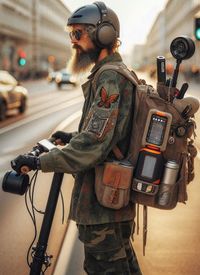Integration of bicycle and e-scooter couriers in disaster management
The use of bicycle and e-scooter couriers could be expanded nationwide in practice. In emergency situations where electronic communication means fail, bicycle couriers can be a very valuable resource to maintain important communication and logistics functions even when conventional infrastructures fail, such as during a blackout. Many well-known projects and training programs are focused more on the general safety and efficiency of bicycle couriers in everyday life, not specifically on disaster scenarios like blackouts or floods. The bicycle market in Germany and Europe is continuously growing, especially in the area of e-bikes. Traditional disaster management plans heavily rely on electronic communication means such as mobile phones, the internet, and landlines. These technologies are prone to failures during power outages or network overloads, which can significantly impair communication during crises. The use of motorized vehicles can be hindered in urban areas by traffic jams and road damage. In rural or inaccessible areas, vehicles cannot always be reliably deployed. It is a great opportunity to complement traditional methods nationwide, thus opening up new possibilities for coping with crisis situations and exploring and testing new innovative approaches to improve the resilience and efficiency of disaster management.
- Establishment of a courier network consisting of voluntary bicycle and e-scooter couriers who are ready to be deployed in emergencies. The inclusion of volunteers as bicycle couriers promotes a sense of community and trust in local disaster protection measures. The full potential of bicycle and e-scooter fleets in crisis situations may not yet be sufficiently known or documented. E-scooters are particularly mobile in urban areas and can quickly navigate through narrow streets and alleys. They can also travel on sidewalks and bike paths, increasing their range and speed. E-scooters are easy to use and require less physical effort than bicycles, making them suitable for longer deployments. They can be easily parked and picked up again, which makes them particularly practical for changing deployment sites. E-scooter couriers could quickly and efficiently transport smaller, urgently needed relief supplies such as medications, water bottles, or first aid kits. E-scooter couriers could be equipped with portable radios or smartphones to relay real-time information about road conditions, blockages, or injured individuals to command centers. They could also act as mobile information transmitters, transporting vital data between field forces and central coordination centers. E-scooter couriers could quickly survey damage areas in large cities and provide current situational images by capturing photos and videos of affected areas. This could help responders make better and quicker decisions. Some e-scooter models could even be used as mobile power sources to charge small electronic devices.
- Regular training and drills for volunteer couriers to ensure they are familiar with the procedures and routes and can act efficiently in emergencies. In some cities, there are bicycle courier services that transport documents and small packages. These services could serve as a model for establishing an emergency courier service. In remote areas or events without electricity, running couriers are sometimes used to convey messages. This shows that the use of manual transmission methods is feasible.
- Planning and establishing safe and efficient courier routes within communities and cities, as well as the use of fixed call and report points in combination with bicycle and e-scooter couriers.
- Development of clear communication protocols and methods to quickly and securely relay information. Bicycle and e-scooter couriers complement and strengthen traditional communication methods rather than replace them. They could also always serve as a backup system that gets activated immediately in the event of a traditional method failure. Ensuring seamless cooperation between traditional and new communication methods.
- Regular emergency drills, practicing the use of e-scooters and bicycles. Equipping couriers with necessary tools such as maps, radios, and first aid kits.
- Close collaboration with local authorities and emergency services to coordinate the deployment. In situations where motorized vehicles fail due to technical issues, bicycles could present a reliable alternative.
- Establishment of emergency stations where couriers can pick up and drop off messages and documents.
- Informing the public about the use of bicycle and e-scooter couriers and how they can optimally support them, while raising awareness to build a robust network of bicycle couriers. This involves increasing community awareness and willingness to actively participate.
- Collaboration with organizations such as cycling clubs to gain additional resources and volunteers. Rental companies could provide their fleets of bicycles and e-scooters to increase mobility in urban areas during an emergency. E-scooters could also be used as mobile power sources to charge small devices. Coordinating large fleets of bicycles and e-scooters, including their maintenance and availability during emergencies, presents significant logistical challenges that should not be dismissed outright. Establish mobile charging units and emergency generators to ensure the power supply for e-scooters in the event of a blackout. Provide vehicles specifically equipped for the transport and maintenance of e-scooters and bicycles.
- Designate coordinators to organize and oversee the deployment of bicycle couriers. The use of rental vehicles in an official disaster response could raise complex regulatory and legal questions that need to be addressed first.
- Implementing safety measures to protect couriers, especially in dangerous or inaccessible areas. Currently, there may be few pilot projects that have tested the use of bicycle and e-scooter rentals in disaster management. To overcome these hurdles and harness the potential of bicycle and e-scooter rentals in disaster management, the following steps could be taken: conducting pilot projects in selected cities like Vienna, Munich, Berlin, Stuttgart, Paris, Rome, New York... to test feasibility and benefits; promoting close cooperation between rental companies, authorities, and aid organizations; developing financing models to cover the costs of using rental vehicles in emergencies; and launching awareness campaigns to highlight the potential of these innovative approaches. By taking these measures, mobility and flexibility in disaster management could be significantly improved, and bicycle and e-scooter rentals could make a vital contribution.
- Conducting test runs under realistic conditions to verify the system's effectiveness, as well as pilot projects in selected cities and communities to test and evaluate the use of bicycle couriers in disaster situations.
- Continuous collection of feedback from couriers and the population to continuously improve the bicycle courier system.
- Inclusion of bicycle and e-scooter couriers in the official disaster management plans of cities and communities. Regularly involving volunteers in emergency drills to test their skills and strengthen cooperation. Updating existing emergency plans to define the specific roles and tasks of bicycle and e-scooter couriers.
- Promotion and recognition of volunteers who serve as bicycle couriers, as the use of bicycles is environmentally friendly and sustainable, not requiring fossil fuels. Conducting targeted recruitment campaigns to attract volunteers interested in training as bicycle or e-scooter couriers.
- Development of training programs that impart specific skills, including: operation and maintenance of bicycles and e-scooters, first aid knowledge and emergency care, communication techniques, especially the use of radios, navigation, and orientation in urban and rural areas.
Example scenario: In Vienna and the surrounding area, a series of fixed call and report points are set up to ensure that messages and information can be transmitted effectively in the event of a power or communication outage. Development of training programs specifically focused on the use of bicycle couriers during blackouts or floods. Bicycle couriers take on the transport of these messages between the report points and central coordination centers. Selection of strategically advantageous locations within the city or district, such as schools, community centers, hospitals, and fire stations, which can serve as call and report points. Establishment of checkpoints along the courier routes to enable regular information transfer and control. Selection and training of volunteers or municipal employees who operate the call and report points and serve as the first point of contact for the population. Use of short, clear, and standardized message formats to ensure the efficiency and comprehensibility of the transmitted information. Provision of necessary equipment such as notepads, pens, maps, radios, and emergency aid kits (waterproof containers, first aid materials, and manual chargers), reflective vests and helmets for increased safety, as well as emergency whistles or horns to attract attention in emergencies. Equipping bicycle couriers with emergency kits that contain basic medical supplies and communication tools to provide first aid in emergencies. Development of flexible deployment plans that allow bicycle couriers to switch between different routes and tasks as needed. Informing the population about the existence and purpose of call and report points through flyers/posters (supermarket, hardware store, banks, car dealerships ...), community newsletters, church bulletins, social media, and local newspapers. Involving local businesses to provide additional resources such as secure bicycle storage and rest areas for couriers. Use of e-bikes to increase the range and speed of bicycle couriers, especially in hilly or sprawling areas. Implementation of security measures at report points, such as lighting, surveillance cameras, and security personnel to ensure the safety of the population and the couriers. Development of specific emergency plans for various disaster scenarios that define the exact role of call and report points and bicycle couriers. Regularly conducting test runs and disaster drills to check and optimize the efficiency of report points and the coordination of bicycle couriers. Collecting feedback from the population, disaster management personnel, and bicycle couriers after every drill or actual deployment, and continuously adjusting and improving the system. Ensuring that the call and report points, as well as the deployment of bicycle couriers, are fully integrated into the existing disaster protection plans of cities and communities and coordinated with other emergency measures.
An example of advanced routing services in disaster management is the openrouteservice (ORS), which uses up-to-date data from OpenStreetMap and is updated in real-time. This service helps first responders navigate around critical infrastructure and make quicker decisions. However, ORS focuses more on the efficiency and safety of routes rather than specific pacing techniques. For bicycle or e-scooter couriers, the specific approach of a pacing route planner, considering regular rest points and minimal physical strain, could be further developed.
Pacing workshops and more for bicycle couriers:
1. Conduct simulated missions with regular breaks to minimize physical strain and practice pacing principles. Interactive exercises where couriers go through different scenarios to learn how to manage their energy optimally.
2. A mentoring program where experienced bicycle couriers or medical professionals act as mentors to provide individual support and guidance to couriers.
3. Establishing a network of volunteers, for example, to support individuals affected by Long Covid / ME/CFS in everyday life and help implement pacing techniques. Regular meetings and sharing of best practices to strengthen community support.
4. Establishment of special zones in the city or community that serve as rest and recovery areas for couriers. These zones could be equipped with seating, shade structures, and water stations to allow for optimal recovery.
5. Setting up solar charging stations at strategic points in the community to charge e-bikes even without mains power during a blackout.
6. Collaboration with local businesses that may have their own emergency generators or solar systems to provide charging capacities.
This contribution was written by Birgit Bortoluzzi, the creative founder of the “University of Hope” – an independent knowledge platform with a mission: to make resilience, education, and compassion visible and audible in a complex world.
Source Reference
(1) Statista (2025) Market data on the bicycle industry in Germany (Statista Market Outlook: Bicycles). Available at: https://de.statista.com/outlook/mmo/fahrraeder/deutschland (Retrieved: January 27, 2025)

